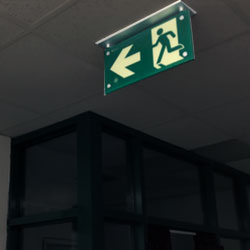









In recent years, a growing focus has been on enhancing accessibility and inclusivity in public spaces. For people with disabilities, navigating buildings and unfamiliar environments can pose numerous challenges. This is especially true for individuals with vision impairments who rely heavily on non-visual cues to orient themselves and detect potential hazards.
Photoluminescent guidance systems offer an innovative solution to support wayfinding and safety for the visually impaired and other people with disabilities. In this blog, we'll explore what photoluminescent systems are, how they work, their key benefits, and how they can transform spaces to be more accessible and disability-friendly.
Photoluminescent guidance systems use photoluminescent markings, indicators, and signs to outline travel paths and highlight key features in a building or public space.
Photoluminescence is the phenomenon where certain materials absorb, store, and emit light. Photoluminescent signs and markers absorb ambient light when exposed, then glow in low-light conditions without needing electricity. This self-powered illumination lasts for hours after the lights go out.
Photoluminescent guidance systems strategically incorporate glow-in-the-dark signs, indicators, strips, and labels to achieve the following:
Photoluminescent guidance systems rely on patented photoluminescent coatings made of non-toxic materials such as strontium aluminate. These coatings fully charge when exposed to ambient light sources, be it natural light, overhead lighting, or emergency lighting.
Once charged, the photoluminescent signs, strips, and markers emit a bright green glow, even in complete darkness. The glow can last up to 70 hours on a single 1 hour of 54lux charging, providing extended guidance.
The photoluminescent indicators absorb and re-emit light, requiring no batteries or wiring. This makes them a reliable and cost-effective safety solution. They are also sustainable as they consume no energy for operation.
To implement an effective system, photoluminescent guidance indicators must be installed strategically along paths of travel per approved photoluminescent code compliance guides like UL 924 or NBC requirements. Proper placement is crucial for optimal visibility and usefulness.
Photoluminescent markings illuminate exit routes in emergencies, low-light conditions, and power failures. This aids in safe evacuation and prevents panic or accidents.
The bright visual cues and tactile components guide people with visual and cognitive disabilities to safely navigate spaces, especially in unfamiliar environments.
Photoluminescent signs work reliably in all conditions as they need no batteries or wiring. This makes them ideal for emergency preparedness.
Photoluminescent guidance systems comply with accessibility standards like the NBC, ADA, IBC, and relevant provincial codes when properly installed. This ensures legal conformity.
Photoluminescent markings consume no energy, reducing environmental impact and utility costs. They also have long lifespans of up to 25 years, decreasing replacement needs.
The visibility of photoluminescent guidance systems helps guide all users, regardless of abilities, in complex buildings and spaces, especially under stressful emergency conditions.
By incorporating standardized guidance indicators in environments, architects and contractors can transform them into accessible, disability-friendly spaces that support wayfinding, independent mobility, and safety for the visually impaired and people with other disabilities.
Let's look at some examples of how photoluminescent systems enhance accessibility:
The strategic use of photoluminescent visual and tactile elements per recognized standards ensures continuous access and safety for those who have vision disabilities. It enables them to move through environments seamlessly while remaining aware of potential hazards and navigation choices.
As Canada's leading supplier of photoluminescent guidance systems, Tactile Solution Canada offers UL-certified solutions from trusted brands like Ecoglo to enhance accessibility, safety, and emergency preparedness.
Our key products include:
By consulting the accessibility standards specific to each Canadian province and territory, architects and contractors can integrate photoluminescent guidance systems into designs to create inclusive, Code-compliant spaces that accommodate all users.
Some common examples are photoluminescent exit signs, stair nosings, handrail markers, hazard markings, and fire/emergency signage. These markings provide visual guidance and hazard warnings in low-light conditions.
Photoluminescent systems are required in public buildings and spaces as per accessibility regulations like the National Building Code of Canada and relevant provincial codes.
They help people who have vision, cognitive, or other disabilities to safely and independently navigate and evacuate buildings, especially in emergencies or low lighting.
Transit platforms, airports, office buildings, healthcare facilities, sports stadiums, multifamily housing, theatres, and other public spaces can be made accessible with the standardized installation of photoluminescent guidance indicators.
Quality photoluminescent coatings glow brightly for at least 70 hours after a 30-60-minute lux charge. This provides extended visibility in dark conditions.
Photoluminescent guidance systems enhance accessibility, emergency preparedness, and safety in buildings and public environments, especially for people with disabilities. Strategic use of standardized photoluminescent visual and tactile components per recognized codes ensures continuous wayfinding, hazard identification, and navigation aid for the visually impaired.
To learn more about creating accessible and inclusive spaces with photoluminescent guidance systems, contact the experts at Tactile Solution Canada today.
